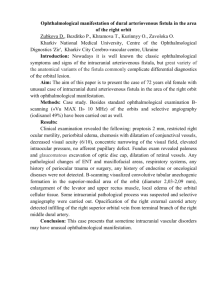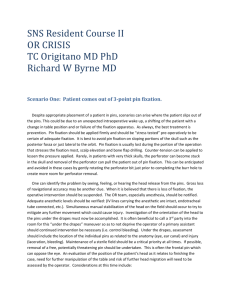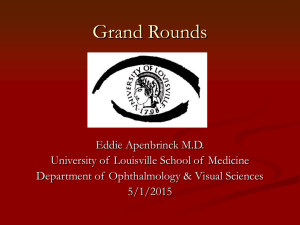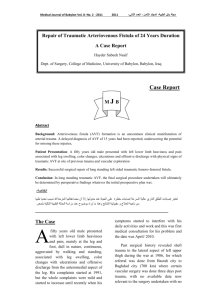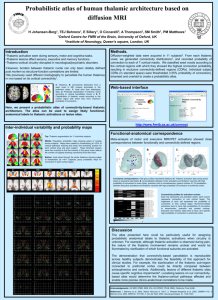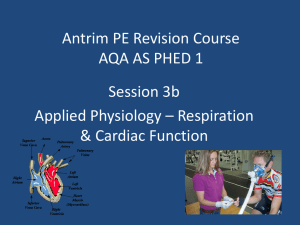Dural Arteriovenous Fistulas
advertisement
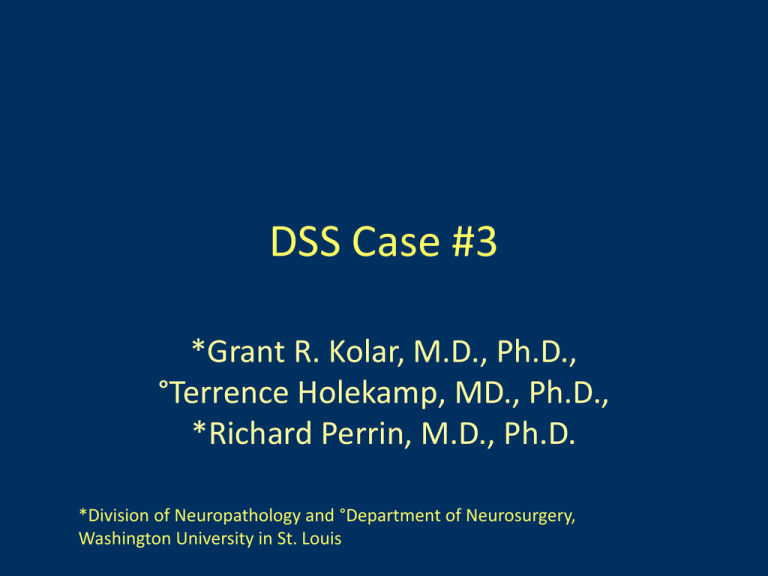
DSS Case #3 *Grant R. Kolar, M.D., Ph.D., °Terrence Holekamp, MD., Ph.D., *Richard Perrin, M.D., Ph.D. *Division of Neuropathology and °Department of Neurosurgery, Washington University in St. Louis Disclosure • There are no financial relationships to disclose. Brief History Received • 60 year old man transferred after 4 days (presented at 1 day) of worsening confusion and memory deficits • PMHX: CAD, MI, HTN • Physical Exam: Drowsy and uncooperative, saccadic intrusions of ocular pursuits, right pronator drift, mild bradykinesia • Social HX: 8 drinks or more per day MRI (FLAIR) • • Compression of 3rd ventricle Bilateral thalamic T2 hyperintensities with homogeneous enhancement • Scattered nonspecific T2 hyperintensities in cortex DDX: 1. Lymphoma 2. Glioma 3. Encephalitis 4. Wernicke’s encephalopathy 5. CO poisoning PET • • Mild asymmetric hypermetabolism DDX: lymphoma or high grade glioma Stereotactic Needle Biopsy CD68 GFAP Histopathology Summary • Reactive and mildly proliferative endothelial changes • Petechial hemorrhages, minute hemosiderin deposits • Mild reactive gliosis and mild edema • Microinfarcts w/spheroids, small foamy macrophages, rare red neurons, and sparing of adjacent neurons Discussion and DDX DDx •Arterial Infarction (Bithalamic – Artery of Percheron Infarction) •Tumor •High-grade glioma •Lymphoma •Toxicity •Wernicke’s encephalopathy •Carbon monoxide poisoning •Hepatic encephalopathy •Deep venous system thrombosis •Thalamic venous hypertension Several weeks later … • Re-review of MRI noted large vein (originally not reported) Followup MRA • Showed abnormal venous channel (involving vein of Galen and confluence of sinuses) with arterialized flow • (right common carotid angiogram) Internal Cerebral Veins (paired) and Vein of Galen (Straight Sinus Thrombosed) Dural Arteriovenous Fistula (dAVF) Right Occipital Artery Borden-Shucart Type III tentorial dAVF (Zipfel type 3s) After Embolization and Surgical Ligation Red = before treatment; Black = after treatment Answer • Hypertensive Venous Infarction Secondary to a Tentorial Dural Arteriovenous Fistula Dural Arteriovenous Fistulas • Rare vascular malformation – 10-15% of intracranial vascular malformations • Abnormal direct connection between dural arteries and cerebral venous system – Most appear acquired with: • Sinus thrombosis • Intracranial venous hypertension • Also may result from prior surgery, trauma, or idiopathic causes – In contrast arteriovenous malformations (AVMs) are • Parenchymal • Congenital Experimental Etiology of dAVFs Other Venous HTN Sinus Thrombosis Retrograde Flow and Enlargement of Veins Chronic Regional Hypoperfusion Induction of VEGF Matrix Metalloproteinase 9 (MMP9) dAVF Formation Chen L, Mao Y, et al. Local Chronic Hypoperfusion Secondary to Sinus High Pressure Seems to be Mainly Responsible fo the Formation of Intracranial Dural Arteriorvenous Fistula. 2009. Neurosurgery 64:973 dAVF Clinical Presentation • Flow related – Pulsatile tinnitis – Opthalmological phenomenon • Incidental *Intracranial hemorrhage *Non hemorrhagic neurological deficits – – – – Often misdiagnosed and given unnecessary procedures Overall 25-55% rate in high grade dAVFs Focal neurological deficits Dementia-like syndrome • 20-27% of patients with high grade dAVFs • Cortical vs Thalamic patterns *Hemorrhage AND non-hemorrhagic neurological deficits signal high risk dAVFs – Carry the same risk of future bleed Imaging of Thalamic dAVFs Cerebral angiography -- gold standard of diagnosis – 100% show multiple supply vessels – 90% involve branches of external carotid artery Venous drainage determines level of risk for future hemorrhage • Cortical Venous Drainage vs. Direct Sinus Drainage • MRI – – • Bithalamic T2 hyperintense signal (100%) Absence of diffusion weighted imaging (DWI) positivity (100%) Peripheral post-contrast enhancement Central hypointensity (hemosiderin deposition) SPECT – Abnormal thallium 201 can correspond to venous reflux – May have low NAA and elevated lactate • PET – Reduced cerebral blood flow (venous congestion) – Increased oxygen extraction fraction (initially) followed by decrease (cellular death and compensation) Histological Features of Thalamic dAVFs • Acute-subacute anoxic damage – Anoxic change in neurons – Scattered axonal spheroids – Microinfarcts – Lipid laden (foamy) macrophages • Moderate microvascular response – Reactive endothelium Treatment dAVF • Embolization • Craniotomy with clip ligation Without treatment, higher grade thalamic dAVFs (reflux into internal cerebral veins) are usually fatal Usually patients demonstrate remarkable progressive cognitive and radiological improvement if treatment is timely. Conclusion • Differential diagnosis of bithalamic T2 hyperintensities and lack of DWI signal with cognitive decline must include a thalamic dural arteriovenous fistula • Cerebral angiogram is gold standard of diagnosis • Histologic features are relatively nonspecific • Outcome is correlated with rapid treatment (fatal if untreated) References • • • • • • Chen L, Mao Y, Zhou LF. Local chronic hypoperfusion secondary to sinus high pressure seems to be mainly responsible for the formation of intracranial dural arteriovenous fistula. Neurosurgery 64:973-8, 2009 Holekamp TF, Murphy RKJ, Kolar GR, Morparia NP, Derdeyn CP, et al. dAVF-Related Thalamic Dementia (DRTD) Syndrome: case series and literature review. Manuscript in progress/submitted. Morparia N, Miller G, Rabinstein A, Lanzino G, and Kumar N. Cognitive decline and hypersomnolence: thalamic manifestations of a tentorial dural arteriorvenous fistula (dAVF). Neurocritical Care 17:429, 2012 Rodriguez FJ, Crum BA, Krauss WE, Scheithauer BW, Giannini C. Venous congestive myelopathy: a mimic of neoplasia. Mod Pathol. 18:710-8. 2005 Sugrue PA, Hurley MC, Bendok BR, Surdell DL, Gottardi-Littell N, Futterer SF, et al: High-grade dural arteriovenous fistula simulating a bilateral thalamic neoplasm. Clin Neurol Neurosurg 111:629-632, 2009 Hurst RW, Bagley LJ, Galetta S, Glosser G, Lieberman AP, Trojanowski J, et al: Dementia resulting from dural arteriovenous fistulas: the pathologic findings of venous hypertensive encephalopathy. Am J Neuroradiol 19:1267-1273, 1998 Coronal Angiogram Right Left
